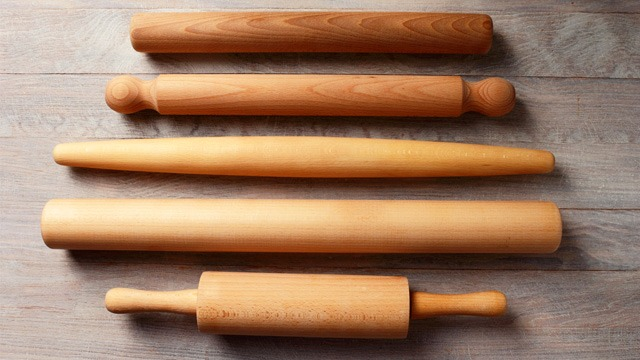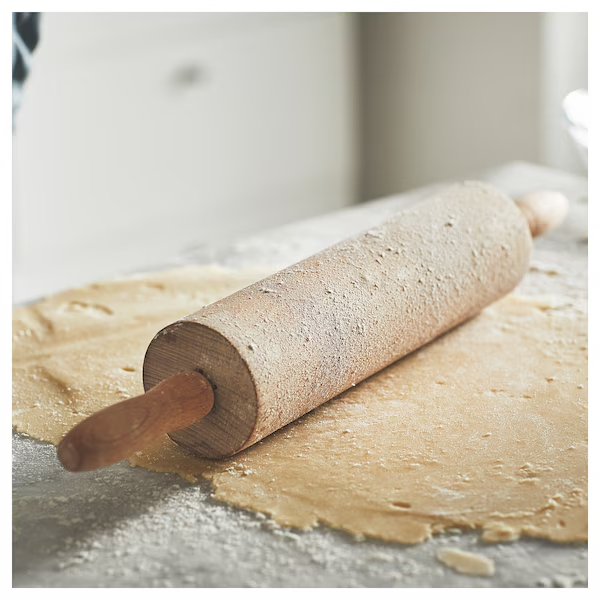Rolling pins are staple utensils in any kitchen, primarily used to shape and flatten dough. While they come in various designs and materials, all rolling pins serve a fundamental role in food preparation, helping bakers achieve the right dough consistency and thickness for countless recipes. In this article, we’ll explore the fascinating history, types, materials, and uses of rolling pins, shedding light on why they are still indispensable in today’s culinary world.

The Origins of the Rolling Pin: A Tool Through Time
The history of the rolling pin is as rich as the recipes it helps create. Rolling pins date back to the 9th century, first appearing in what is now Italy, then known as Etruria. The Etruscans were known for their intricate cuisine and used rolling pins made of materials like wood, clay, stone, and even glass to prepare food. The tool was later adopted by the Greeks and Romans, preserving its legacy.
By the mid-1800s, rolling pins began to be commercially manufactured, with maple and cherry wood being the favored materials. In the late 1800s, J.W. Reed introduced the handled rolling pin, a significant innovation that allowed bakers to roll dough without touching the pin’s surface directly, keeping their hands clean. Despite the evolution of design, the purpose of the rolling pin remains the same: to roll out dough evenly and efficiently.
Different Types of Rolling Pins and Their Uses
Over the years, various types of rolling pins have emerged, each with unique characteristics suited to different tasks. Here are the main types:
1. Rod Rolling Pins
Rod-style rolling pins are long, slender, and typically without handles. This style is popular in East Asian and French kitchens and is ideal for tasks that require delicate rolling, such as making dumpling skins or pie crusts. Rods can be tapered at the ends for greater pivot control, making them suitable for more intricate baking tasks.
2. Roller Rolling Pins
Roller-style rolling pins are thicker in the middle and come with handles, making them easy to grip and apply pressure evenly. This type is commonly found in Western kitchens and is highly effective for rolling out heavier doughs like pizza and pie crusts. The handles give users more control, making it a preferred choice for novice bakers.
3. Textured Rolling Pins
These specialty pins have embossed patterns or textures on their surfaces, allowing bakers to imprint unique designs on the dough. Textured rolling pins are excellent for decorative baking projects, such as creating intricate designs on cookies, breads, and pasta.

4. Chakla Belan
In Indian cooking, rolling pins (belan) are used with a flat circular rolling board (chakla) to make traditional breads like chapatis. This combination provides a sturdy base, ensuring an even roll for thin, round flatbreads. The chakla belan has become a cultural symbol in Indian kitchens and remains popular for its practical use.
Choosing the Right Material for Your Rolling Pin
Rolling pins come in various materials, each with unique properties that affect how they handle and perform. Here’s a breakdown of the most common materials:
Wooden Rolling Pins
Wooden rolling pins are the traditional choice, known for their durability and non-stick qualities. Maple and cherry wood are popular options because they resist absorbing moisture and odors. Wooden rolling pins are versatile and suitable for most dough types, but they require regular conditioning to maintain their quality.
Marble Rolling Pins
Marble rolling pins are ideal for pastry dough that needs to stay cool, such as puff pastry or croissants. Marble’s natural coolness prevents butter from melting into the dough, resulting in flakier pastries. Many bakers chill marble rolling pins before use to enhance this effect. However, they are heavier and can be challenging to handle for extended use.
Stainless Steel Rolling Pins
Stainless steel rolling pins are lightweight, easy to clean, and have a sleek, modern appearance. They are often preferred by professional chefs for their ease of handling and non-reactive surface, which doesn’t absorb flavors. Stainless steel pins can also be chilled to keep the dough from sticking, making them a practical choice for various types of baking.
Silicone Rolling Pins
Silicone rolling pins offer a non-stick surface, making them perfect for sticky doughs. They are easy to clean and often dishwasher-safe, which adds to their convenience. Silicone rolling pins are available in multiple colors and sizes, making them an attractive choice for home bakers looking to add a pop of color to their kitchen.
Glass and Ceramic Rolling Pins
Glass and ceramic rolling pins are less common but serve specific purposes in the kitchen. Some hollow glass rolling pins can be filled with cold water to keep the dough at an optimal temperature. Ceramic rolling pins, though delicate, are often decorative and can add a unique touch to a baker’s collection.
The Essential Role of Rolling Pins in Baking

Rolling pins play a crucial role in various baking processes, from rolling out cookie dough to preparing puff pastry. Here’s a closer look at some of their most popular uses:
- Pie and Tart Dough: Rolling pins help create an even layer of dough, which is essential for a perfect pie crust. Roller-style pins are often preferred for this task as they allow for even pressure distribution.
- Pastry Dough: Marble and stainless steel pins are ideal for rolling out pastry dough, as they can be chilled to keep the butter from melting. This ensures a flaky, light texture in pastries like croissants and danishes.
- Decorative Baking: Textured rolling pins make it easy to create decorative designs on bread, cookies, and pastries. These pins are perfect for adding a personalized touch to baked goods.
- Flatbreads and Chapati: Rod and chakla belan rolling pins are essential for preparing thin flatbreads. The smooth rolling motion helps achieve an even thickness, which is crucial for traditional flatbreads like chapatis, tortillas, and lavash.
Innovations in Rolling Pin Design
As baking continues to evolve, so too do the tools we use. Modern innovations have introduced rolling pins with adjustable thickness rings, which allow bakers to set precise measurements for rolling dough. This feature is particularly helpful for recipes that require uniform thickness, such as sugar cookies and pie crusts.
Another popular innovation is the patterned rolling pin, which embosses designs directly into the dough. Available in a variety of patterns and shapes, these pins make it easy to create intricate designs without extra tools.
Caring for Your Rolling Pin
To ensure your rolling pin lasts a lifetime, proper care is essential. Wooden rolling pins should be hand-washed and dried immediately to prevent warping. They should also be conditioned regularly with mineral oil to keep the wood from drying out. Marble, stainless steel, and silicone pins are easier to maintain and can usually be wiped clean or washed with soap and water.
Conclusion
Rolling pins may seem like simple kitchen tools, but their impact on baking cannot be overstated. With a rich history, versatile designs, and a variety of materials, rolling pins continue to be a vital tool for chefs and home bakers alike. Whether you’re making a simple batch of cookies or crafting a delicate pastry, the right rolling pin can make all the difference in your culinary creations. Embrace the timeless appeal of this essential tool, and discover the endless possibilities it brings to your kitchen.


